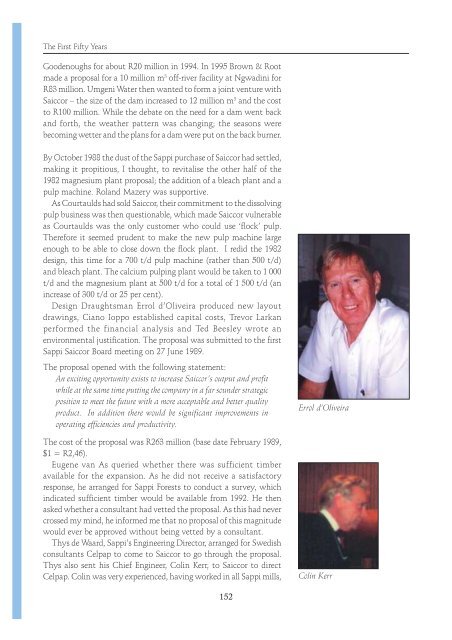You also want an ePaper? Increase the reach of your titles
YUMPU automatically turns print PDFs into web optimized ePapers that Google loves.
<strong>The</strong> <strong>First</strong> Fifty <strong>Years</strong><br />
Goodenoughs for about R20 million in 1994� In 1995 Brown & Root<br />
made a proposal for a 10 million m 3 off-river facility at Ngwadini for<br />
R83 million� Umgeni Water then wanted to form a joint venture with<br />
<strong>Saiccor</strong> – the size of the dam increased to 12 million m 3 and the cost<br />
to R100 million� While the debate on the need for a dam went back<br />
and forth, the weather pattern was changing; the seasons were<br />
becoming wetter and the plans for a dam were put on the back burner�<br />
By October 1988 the dust of the <strong>Sappi</strong> purchase of <strong>Saiccor</strong> had settled,<br />
making it propitious, I thought, to revitalise the other half of the<br />
1982 magnesium plant proposal; the addition of a bleach plant and a<br />
pulp machine� Roland Mazery was supportive�<br />
As Courtaulds had sold <strong>Saiccor</strong>, their commitment to the dissolving<br />
pulp business was then questionable, which made <strong>Saiccor</strong> vulnerable<br />
as Courtaulds was the only customer who could use ‘flock’ pulp�<br />
<strong>The</strong>refore it seemed prudent to make the new pulp machine large<br />
enough to be able to close down the flock plant� I redid the 1982<br />
design, this time for a 700 t/d pulp machine (rather than <strong>50</strong>0 t/d)<br />
and bleach plant� <strong>The</strong> calcium pulping plant would be taken to 1 000<br />
t/d and the magnesium plant at <strong>50</strong>0 t/d for a total of 1 <strong>50</strong>0 t/d (an<br />
increase of 300 t/d or 25 per cent)�<br />
Design Draughtsman Errol d’Oliveira produced new layout<br />
drawings, Ciano Ioppo established capital costs, Trevor Larkan<br />
performed the financial analysis and Ted Beesley wrote an<br />
environmental justification� <strong>The</strong> proposal was submitted to the first<br />
<strong>Sappi</strong> <strong>Saiccor</strong> Board meeting on 27 June 1989�<br />
<strong>The</strong> proposal opened with the following statement:<br />
An exciting opportunity exists to increase <strong>Saiccor</strong>’s output and profit<br />
while at the same time putting the company in a far sounder strategic<br />
position to meet the future with a more acceptable and better quality<br />
product� In addition there would be significant improvements in<br />
operating efficiencies and productivity�<br />
<strong>The</strong> cost of the proposal was R263 million (base date February 1989,<br />
$1 = R2,46)�<br />
Eugene van As queried whether there was sufficient timber<br />
available for the expansion� As he did not receive a satisfactory<br />
response, he arranged for <strong>Sappi</strong> Forests to conduct a survey, which<br />
indicated sufficient timber would be available from 1992� He then<br />
asked whether a consultant had vetted the proposal� As this had never<br />
crossed my mind, he informed me that no proposal of this magnitude<br />
would ever be approved without being vetted by a consultant�<br />
Thys de Waard, <strong>Sappi</strong>’s Engineering Director, arranged for Swedish<br />
consultants Celpap to come to <strong>Saiccor</strong> to go through the proposal�<br />
Thys also sent his Chief Engineer, Colin Kerr, to <strong>Saiccor</strong> to direct<br />
Celpap� Colin was very experienced, having worked in all <strong>Sappi</strong> mills,<br />
152<br />
Errol d’Oliveira<br />
Colin Kerr

















